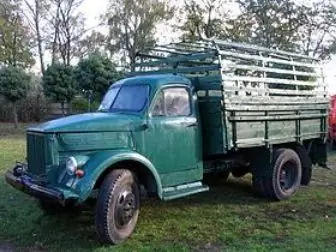2026 Author: Erin Ralphs | [email protected]. Last modified: 2025-01-22 21:14:11
Zaporozhye Automobile Plant was established in the early 60s of the last century. The main direction of his activity was the production of small cars, which were in great demand in the USSR. And a large number of ZAZ vehicles were supplied to social services to provide for war invalids.
The design office set up at the plant, which consisted of quite experienced specialists, willingly took on new machine projects. It was this project that became the beginning of the history of ZAZ-970.
First prototype
The development of a small-capacity truck based on existing and promising models began in Zaporozhye already in 1961. The ZAZ-966 car, which was being prepared for production, was chosen as a platform for the car. It allowed more flexible use of available opportunities.
The project was named "Tochilo" and was developed under the leadership of Yuri Sorchkin. After some time, a promising truck with a tonnage of 0.35 tons was given the factory index ZAZ-970.

Truck family
A year later, cars of the new Tselina family were presented,the development of which took into account the experience of designing a truck of the first model. The family included the following modifications:
- 970B - with an all-metal van-type body;
- 970G - pickup style;
- 970В - with a cargo-passenger body.
The external design of the new machines was created by Yu. V. Danilov, and L. P. Murashov was responsible for the mechanical part, who, working at the MZMA plant, was directly involved in the creation of Moskvich-444.
When creating running prototypes, a method was used that significantly accelerated the production of body panels. To do this, life-size drawings of parts were created and wooden blanks were made from them, which acted as improvised molds. Body panels were also knocked out by hand.
For the manufacture of these parts, a special steel sheet was used, only 0.7 mm thick. Since errors are inevitable with this method, the shape and cross section of many power elements (for example, spars of a load-bearing body) were selected experimentally.
Power plant
The ZAZ-970 car was equipped with a standard four-cylinder 887 cc MeMZ-966 engine, borrowed from the humpbacked ZAZ-965A. The motor had two rows of cylinders placed on a common crankcase at a right angle. A four-speed gearbox, completely borrowed from the passenger model, was docked to the rear of the engine. The use of a standard passenger platform adversely affected the performance of the ZAZ-970, since the rear-mounted engine createda large hump on the floor of the loading platform.
For the suspension, a scheme similar to the 966th model was used - torsion bar in front and spring in the back. Due to the increased maximum permissible weight of the ZAZ-970, a number of reinforced elements were used in the suspension. Wheels and tires remained similar to ZAZ passenger products. But special gearboxes were installed in the drive of the rear drive wheels, which lowered the speed of the output shafts.
Thanks to a well-designed transmission, it was possible to provide good technical characteristics of the ZAZ-970. Such an important parameter as fuel consumption did not exceed 7.5 liters of gasoline type A76 for every hundred kilometers. At the same time, the truck could accelerate to 70 km / h, which was quite enough for the urban pace of movement of those years.
Van Features
On the described machines, it was supposed to install a blank partition directly behind the driver and passenger seats. The enclosed cargo compartment had a useful volume of about 2500 liters. At the same time, it was supposed to produce two variants of vans:
- With rear doors of two symmetrical halves and blind sides.
- With a blank back wall and single-leaf doors in the sidewalls.
You can see a variant of the van based on the ZAZ-970 in the photo in the article.

Community vehicle
This variant was basically the same as the van, but there were four additional passenger seats in the back. Thus, the total capacity of the car was six people (including the driver).
The last row of seats was a significant distance from the middle one, since that was where the bulging engine cover was located.

The seats could be folded in rows, which made it possible to place from 175 to 350 kg of various types of cargo. A distinctive feature of the body was a single door for access to the rear of the cabin, cut into the right sidewall. For additional ventilation, there was a rectangular hatch on the roof panel.
Zaporozhye pickup truck
The last version of the ZAZ-970 was equipped with an open rectangular platform located behind a double closed cabin. On the floor, the dimensions of the platform were 1.4 m long and 1.24 m wide. When the load was located above the engine hood, the length of the platform increased to 1.84 m, with a width of 1.4 m. Due to the reduced weight of the body, the pickup truck's load capacity increased by 50 kg.

Loading was carried out through folding doors located on the left side of the body. The door leaves were symmetrical. A big plus of the cargo options was the low loading height, which was only half a meter from the road level.
With all the hosts
Since in the same years active work was carried out on all-terrain versions of ZAZ cars, Tselina did not remain deprived of this version either. To drive the front wheels, an additional pipe was introduced into the transmission design, inside which was placed a shaft with a spline connection. The upper part of the ZAZ-971D car (this is the name the car got) was covered with canvasawning on a rigid tubular frame.

This truck, with a carrying capacity of about 0.4 tons, showed very good off-road performance. The main disadvantage was the monstrous fuel consumption, which has exactly doubled - up to 15 liters.
Tests
Tests of machines were carried out on the territory of the then Ukrainian SSR, including in the Crimea. At the same time, representatives of a number of trade organizations were invited as spectators to such tests, to meet the needs of which the ZAZ-970 truck was created. In addition to Soviet cars, foreign samples also participated in the tests (for example, Renault Relay, similar in design and purpose). During the tests, the cars covered more than 20 thousand km, but breakdowns were recorded:
- jamming of gears and shafts of the box;
- ripped engine mounts;
- breakdown of the pendulum steering assembly;
- destruction of suspension arm brackets;
- cracks on side members and other body parts.
All these defects were carefully analyzed by the specialists of the plant and numerous improvements and changes were introduced into the design. After all the adjustments, another short run (5 thousand km) was carried out, which did not reveal any breakdowns.

For 1963, state tests of a batch of cars were appointed and carried out (two copies with a van body and two with a cargo-passenger body). At the same time, the cars had full and rear-wheel drive. After testing carsreceived additional tests in Moscow and the region. During these tests, complaints were caused by the ventilation system, overheating of the cargo compartment from the engine and deformation of the floor panels.
But the process of development of ZAZ-970 "Tselina" did not advance further than testing, since the Kommunar plant was already overloaded with existing orders for cars. In addition, ZAZ received an order for the revision and serial protrusion of the TPK army vehicle, so the plant could not cope with the production of another line of vehicles. Not a single copy of "Vselina" has survived to this day.
Recommended:
Ford GT car: specifications, history, photos

The American company Ford Motor Company developed the first generation of the Mustang in 1964. An active advertising campaign contributed to the fact that this project has become one of the most successful and massive in the automotive world. In just a year, the company has released more than 263 thousand Ford GT off the assembly line, which already says a lot
"Cadillac": country of origin, history of creation, specifications and photos

There are people who are interested in what country is the manufacturer of Cadillac. What is this car famous for? How did its production begin? Who stood at the origins. What are the current popular models? What are their features. Our article answers all these questions
GAZ-51 car: history, photos, specifications

The unique and one of a kind car GAZ-51 is a truck, the production of which became the most massive in the Soviet Union from the 40s to the 70s of the last century. Due to its versatility and load capacity (2500 kilograms), the machine has become widespread in various sectors of the national economy and auxiliary areas
"Maserati": country of origin, history of creation, specifications, power and reviews with photos

Practically everyone who is interested in cars sooner or later dreamed of a Maserati (manufacturing country - Italy). This luxury car brand inspires admiration and respect for its developers. Read about the history of the brand, about which country the Maserati manufacturer is and about the latest line of these supercars, read in this article
Car "Marusya" - the first domestic sports car in the history of the Russian car industry

The Marusya sports car dates back to 2007. It was then that VAZ was offered the idea of creating the first racing car in Russia

